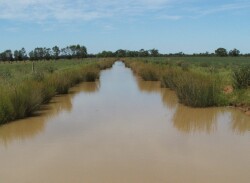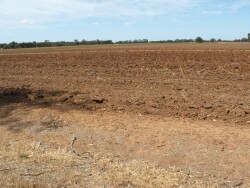State of the art - on irrigation farms - Edition 2
| Who: Rob and Lynne McCartney
Where: Tatura Enterprise: Dairy What: Fully automated bay outlets with telemetry control | State of the art - on irrigation farms - Edition 2 (PDF 644 KB) State of the art - on irrigation farms - Edition 2 (DOC 117 KB) To view the information PDF requires the use of a PDF reader. This can be installed for free from the Adobe website (external link). |
On the farm
What change have you implemented?
Rob and Lynne McCartney installed an AWMA automated irrigation system with telemetry on 13 fast flow outlets. The system was installed on their Tatura property about two years ago and services 20 hectares of irrigated perennial pasture bays. Additional stops and channel modifications were also installed to compliment the technology upgrade.
| The automation system on each outlet has solar powered batteries that operate the gate and is linked by radio to a personal computer in the farm office via an aerial installed on the home’s roof. Irrigation timing and duration can be programmed into the system to make the task of irrigating the bays fully automatic. Why did you implement this change? To Rob and Lynne, automation seemed to be the next step in developing their farm, once laser grading and drainage improvements were completed. The main benefits driving the installation included time saving and reductions in labour costs. They opted for telemetry over other forms of automation, such as basic clock timers, because telemetry offered a higher level of convenience. Clock timers or similar basic units would have meant there was still a need to walk around and set, or relocate, the automation units regularly. Where did you find information to help guide you? Rob and Lynne gained information on the technology through speaking to other farmers, professionals in the field and attending field days. Were you able to gain any assistance for the change? Prior to the installation, Rob and Lynne were successful in gaining a $20,000 grant through the Australian Government drought assistance program for irrigation system improvements, and obtained a further $6,600 grant through the Goulburn Broken CMA farm water savings program. Both grants contributed to the cost of purchasing and installing the automation system. (See Research section below for typical system costs.) | 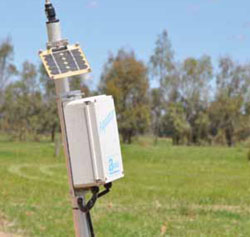 Automated Irrigation System |
What was the result of the change and was the investment worthwhile?
Aside from some minor initial problems, Rob and Lynne believe the benefits of implementing the technology have outweighed the cost, particularly in reducing time and labour inputs. Quantifying these benefits is difficult however, because in large part they involve aspects difficult to measure, such as improvements in their lifestyle and creating greater opportunity to work on other aspects of their farm business.
Were there any set-backs when implementing the automation?
Although there was no exact blue-print to follow, Rob and Lynne were able to gain enough information to make the technology work for their specific farming situation. There is no single automation system that fits all circumstances – so despite feeling well informed, there was a slight level of risk in getting the system customised to their farm. There was an initial period where the couple found it hard to put their entire trust in the system, until it had proved itself. They still find irrigation duration sometimes requires adjustment to avoid under or over irrigation, depending upon the stage of pasture growth, grazing pressure and channel supply level variations.
A lack of training in utilising the computer software was identified as a minor issue. They found the software was not overly complicated and could be installed on their existing computer.
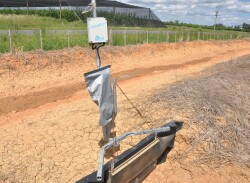 Automated Irrigation System | Why do you think the change has worked? Automation with telemetry has worked well on this part of the McCartney’s farm, which is based on perennial pasture irrigated intensively throughout the irrigation season. The major benefits are in labour and water savings, and so investment in such a technology upgrade may not be justified on irrigation bays that are not irrigated as intensively, such as those growing annual pastures and crops. Do you think other farmers would be interested in this change? The uptake of this technology by other irrigators would depend on a few factors, including financial resources, willingness to adopt new technologies, priorities and individual farm circumstances, and future plans. In the right setting, the system installed by Rob and Lynne McCartney can be a very useful upgrade. Technologies such as these, which make irrigation more efficient and easier on the operator, are likely to become more prevalent. What recommendations would you give to those thinking of installing such technologies? Rob has found it is essential to actually check channels, outlets, bays and drains regularly. With the telemetry system in place, it is easy to just assume all the infrastructure is in good order, when in fact there could be bank decay, blockages in the channel, or leaks around the stops. Channel problems such as these also have the potential to affect the irrigation schedules required, as the automation units do not allow for channel blow outs or changes in water command levels. Any further comments? The McCartney’s Tatura farm is not yet part of the modernised channel network. The couple are interested to see how much more effective their automation units will be once their supply is modernised and they have a more reliable water supply level onto their property. Eventually, the couple would also like to look into installing soil moisture monitoring probes in their irrigation bays, and have them tied into the automatic irrigation units. This could then allow them to more closely match irrigations to the water requirements of their irrigated crops. |
Research
There has been very little research into the water savings benefits of automating border-check irrigation. Improved lifestyle for the farmers, and savings in labour are likely to be the major benefits in the Goulburn Murray Irrigation District (GMID). Unlike water, which varies as a cost of production from year to year, labour costs can be assumed to continue to increase into the future, especially as skilled farm labour becomes scarcer.
A desktop study based on information from two farms in northern Victoria reported by Lavis et al. (2007) concluded that border-check automation was associated with reductions in water use of between 5% and 9%, depending on soil type. The savings arose because with automation, irrigators could continue to irrigate bays individually and efficiently at busy times, rather than adopting the common practice of irrigating several bays at once for longer duration at lower flow rates, reducing their labour input but leading to deep drainage and water losses.
For a given border-check irrigation layout, the two factors an irrigator can control are the rate and the duration of water flow onto the irrigation bay. Both affect the quantity of water applied to the bay. Of these two controls, the duration of irrigation is the easiest to adjust, but its use has mainly been based on experience rather than science to date, because of a range of issues such as:
- variable irrigation supply levels, and therefore variable flow rates onto farms and irrigation bays, which cause inconsistencies for automated systems. Modernisation of the irrigation supply system promises to greatly improve the consistency of irrigation flow rates and alleviate this problem.
- the requirement to order water 4 days ahead has meant the moisture status of bays at the time of irrigation, and therefore the crop water requirement, could be quite variable. Again, system modernisation has largely removed this as a problem, with irrigators now able to order and cancel water with much less notice, meaning irrigations can now be applied more consistently with respect to crop moisture requirement.
Adoption of ‘high flow’ irrigation, at flow rates about twice the levels of recent best practice, will place greater demands on irrigators with respect to timing of irrigation duration – mistakes at high flow rates will be correspondingly greater. Adoption of automation, as made by Rob and Lynne, will help ensure they capture any water saving benefits of high flow rate irrigation.
Reference
Lavis, A., Maskey, R. and Lawler, D. (2007) Quantification of the Farm Water Savings With Automation, Department of Primary Industries, Victoria.
Further information
- For more information about Irrigation Technologies, go to: www.dpi.vic.gov.au/dpi/vro/vrosite.nsf/pages/lwm_farmwater_irrigation_technologies
- Talk to an irrigation surveyor and designer or one of the companies that supplies and installs automated irrigation systems
- Call DPI at Echuca (03 5482 1922) or Tatura (03 5833 5700) and ask to speak to an Irrigation Modernisation Officer.
- Talk to other farmers who have installed automatic irrigation and telemetry control systems
- Outlet and telemetry system costs are typically in the range of $1,000 – $1,800 per outlet, depending upon the type of bay outlet and system size.
..................................................................................... |
Water Delivery Efficiency
Who: The Ryan Family
Where: Yarrawonga
Enterprise: Cropping
What: Old channel system replaced by pipeline
On the farm
| Background This farm has been in the Ryan family since 1865. A major change took place under the partnership of John Ryan’s father and uncle (WL and WL Ryan) in 1956 when they decided to develop a private irrigation diversion from Lake Mulwala on the Murray River. Water was delivered to their properties via a 16 km open, earthen channel. Soil types are predominantly light sandy clay loams with high infiltration rates, growing cereals, oaten hay and lucerne. John and Helene Ryan bought out the partnership in 1997. Their 800 ha property then had a water entitlement of 1,171 ML of high security water which the enterprise used fully. The Ryan’s had always known their 16 km supply channel was inefficient, but the problem really hit home during the drought years of 2006 to 2010 when seepage, leakage and evaporation losses from the supply channel consumed most of their reduced water allocations. What change have you implemented and why did you do it? The original 16 km open channel system has been replaced with a 4.1 km pipeline pumping directly from the Murray River. | 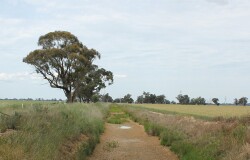 Open channel system |
Where did you find information to help guide you?
The project had been a ‘pipe dream’ for more than a decade, left undeveloped due to the potential cost. John Ryan eventually discussed the idea with Dennis Moon from Campaspe Irrigation, an irrigation designer and supplier, who then developed design options and advanced the concept.
Information about the On-Farm Irrigation Efficiency Program – which helped fund the project – was provided by the Department of Primary Industries. The On-Farm Irrigation Efficiency Program is administered by the Goulburn Broken Catchment Management Authority.
How much did it cost?
The total cost to remove the old system and install the pipeline was approximately $1.5 million. About 75% of this was obtained through the Australian Government’s On-Farm Irrigation Efficiency Program, with the Ryans agreeing to transfer 276 ML of water in order to receive funding to assist with the on-ground works involved.
 Pipeline being installed | What was the result of the change and was the investment worthwhile? The Ryan family believes their enterprise will be more productive and profitable as a result of installing the pipeline. They feel the farm is now more viable and more resilient to the potential impacts of future climate and water policy challenges because they can use their water asset more efficiently. The Ryans believe crop yields were low in the past due to their inefficient irrigation delivery system. They believe the new system will enable new, higher value cropping options. What are the benefits? The project has delivered a range of benefits. Water losses associated with the open channel system are no longer an issue. Improved water metering, installed as part of the new system, provides the ability to accurately measure the water use of individual crops. |
Maintenance costs of the pipeline are much lower compared with the open channel, with herbicide spraying, channel bank repairs and de-silting of the open channel no longer required. Land occupied by channels can now be returned to productive purposes.
The pressurised water supply will allow more precise delivery of water when required, which should lead to improved crop yields and the ability to diversify crops.
A pressurised supply to the farm also paves the way for possible future precision irrigation development, based on sprinkler or drip irrigation technologies.
Overall, the Ryan family has every confidence the new pipeline will deliver the desired result. The new system will definitely provide a better irrigation system, ensuring the long term viability of the property and increasing its value. The new system will be utilised to grow more profitable crops and allow more diverse options to be considered.
Are there any disadvantages?
The pipeline has a higher energy use compared with the open channel system, which is a business risk if energy costs continue to rise. The Ryans considered the trade-off between ongoing pumping costs and the higher initial cost of installing a larger diameter pipe over the pipeline length. By installing a larger diameter pipe than the recommended minimum size, the Ryans reduced the ongoing energy cost of pumping, and the impact of future energy cost increases.
Project management costs, time taken away from the core cropping business and the consequent impact on the Ryan’s lifestyle, were issues during the construction of the project.
Do you think other farmers would be interested in the change?Many people, including neighbouring landholders, have discussed the system with the Ryan family and have watched the progress of the project over the past 15 months.
| Research Irrigation supply channel losses throughout the region account for a major proportion of all the water diverted from the Murray and Goulburn river systems. Channel seepage, leakage and evaporation losses estimated for the large Stuart Murray channel system for the 2005/6 season totalled 31.5% of entitlement (DSE, 2010). For the private 16 km long channel system that previously supplied the Ryan’s property, losses due to seepage, leakage and evaporation of about 50% are quite understandable, considering the permeable soil types and its small channel size. Preventing such significant water losses through piping the supply clearly makes a lot of sense for the Ryans, who during the drought years may have paid for a lot of very expensive water that did not end up on their crops. For many irrigators considering whether to pipe farm channels, the water savings alone would not justify the installation and ongoing operating costs of a piped system. In the context of the whole farm operation however, where water is only one of many inputs to the farming system, other aspects should be considered in the decision. These considerations include labour and maintenance costs, flexibility in farm operations and layout, increased production, new crop options, and improved lifestyle for the operators. | 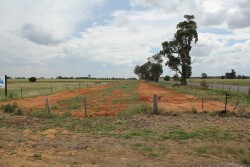 The completed pipeline installation |
The key is to carefully consider these decisions in the context of the whole farm business and the farming family’s plans for the future. Tools available through DPI such as Whole Farm Planning can help irrigators decide what to do in their particular circumstances.
Reference
DSE, 2010. Water Savings Protocol Technical Manual for the Quantification of Water Savings. Department of Sustainability and Environment.
Further information
- For more information about irrigation technologies, go to: www.dpi.vic.gov.au/dpi/vro/vrosite.nsf/pages/lwm_farmwater_irrigation_technologies
- Talk to an irrigation surveyor and designer or a company that supplies and installs pipeline systems.
- Contact the Ryans at the following email address: ryanfarm@activ8.net.au
..................................................................................... |
Adapting to Change
Who: Colin Myers
Where: Kerang
Enterprise: Sheep and fat lambs
What: Transition to dryland farming
On the farm
Background
Colin Myers purchased his property from his father in the early 1980s. It consisted of marginal land with large areas affected by salinity. Over the years, the property has been used for cropping, mixed grazing and vegetable growing. Up until 1990, the traditional carrying capacity was around 1,000 ewes (1,000 DSE) on 230 hectares. To sustain this carrying capacity, most of the income generated from the property was going out in irrigation water pumping costs (around 80%). The property was not on a gravity supply system, so all irrigation water had to be lifted from the Loddon River. Unreliable river levels made irrigations difficult, with the pumps changing flow as the river level dropped. The energy costs involved were high, and floods damaged pumps and motors several times in the 1980s.
What change have you implemented?
The decision to dramatically reduce irrigation on the property occurred in the early 1990s. Based on increasing costs, salinity, and other difficulties combined with reducing commodity prices, the decision came easily. The decision resulted in the selling of a large proportion of the water entitlement.
Colin then became interested in trialling native grasses on his property due to their resilience to drought conditions and salinity. Native grasses have a natural tendency to improve ground cover, such an important aspect in fighting salinity and wind erosion.
Why did you implement this change?
Throughout the 1970s and 1980s irrigation was becoming increasingly unprofitable for the enterprise. The irrigation water source was becoming more unreliable in terms of allocation and quality, while pumping costs were ever increasing. Changing from full irrigation to mainly dryland farming, with intermittent irrigation when high river flows permitted, is closer to natural rainfall events.
Where did you find information to help guide you?
Wanting to know more about his soils and new methods for dealing with salinity, Colin joined the local Landcare Group, where he learnt what his soils required for optimum health and therefore performance in the local area. The added benefit of this knowledge was reduced reliance on chemicals, both fertiliser and herbicide.
“If the soil has the right nutrients in it, quite often you wouldn’t need to use so many chemicals. So we started to look at what the soils need and found organic matter was the main lacking ingredient (down to 1%) and low calcium and high magnesium.” |
Were you able to gain any assistance for the change?
Apart from some assistance in establishing tall wheat grass, there have not been any sources of financial assistance available to Colin for the long term changes he has made. Many of the changes have been made on the basis of speaking to local DPI technical staff, and as many technical people as possible who were able to help.
“People understood where I was trying to get to but were unsure on how to get there and be viable at the same time.” |
Other changes have been the result of Colin trialling different approaches and learning from his successes and failures.
What was the result of the change and was the investment worthwhile?
”The extremely high drought tolerance of native grasses and shrubs helps to make the farm much more flexible and resilient. Whilst we had to move to a much lower stocking rate, we also drastically reduced all the other inputs; no irrigation, no fertilisers, no sprays and much reduced labour. You must take that into account when you look at our stocking rate.” |
Colin hasn’t gone completely to native grasses, so still relies on the introduced pasture species on the property for some production. He says the amount of clover and ryegrass production is now really impressive. Colin suspects it has something to do with the natives providing ground cover, and reducing soil moisture loss and wind erosion.
| Although a reduction in carrying capacity (down to approximately 400 ewes), Colin now sees 80% of income go to his pocket rather than to costs. Whilst irrigation is still possible (1996 was the last event), it is Colin’s approach to flexible farming and adaptation to changing circumstances that is paying dividends. Why do you think the change has worked? “We’ve established and encouraged a number of native species on our property, including hedge saltbush, windmill grass, spear grass, rats tailed couch (grows in saline areas), ruby saltbush and creeping saltbush. All of these are vital to stop the land from drying out and coping with the soil conditions we had.” Do you think other farmers would be interested in this change? 20 years ago the land in picture (below) was bare, saline ground that wouldn’t grow anything. This area has still never been watered except for flooding. Through careful management of stocking rates and looking after soil health, this area has been turned into viable, productive agricultural land. | 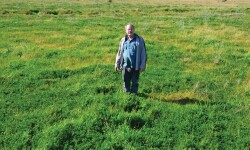 Colin Myers standing on previously severely salinised land |
What recommendations would you give to those thinking of getting out of irrigation?
The key to the successful establishment and utilisation of native grasses and shrubs on Colin’s property has been to carefully manage stocking rates and grazing. Reducing stocking rates to a sustainable level, as well as the timing of grazing to allow seed bank establishment and germination, is vital.
Any further comments?
“I’m now quite happy to hand the property over to my children given the good soil health and increased biodiversity now present.” |
Research
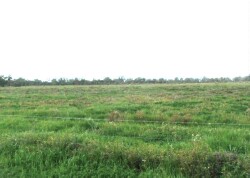 Previously severely salinised land | Colin’s experience in dealing with a range of adverse farming conditions is a great example of someone adapting to change, and making positive decisions to take back some control over their circumstances. Prior to the drought, the land around Kerang was severely affected by salinity. While irrigation on the better soils on the property may have maintained productivity on those areas, it is likely salinity in the surrounding areas was also made worse. Colin’s decision to reduce input costs also challenged the conventional farming business model that usually seeks to expand or become more intensive. While clearly such decisions will not suit many, the choices made are a valid option when dealing with changes that are forced upon the farm enterprise. Much research and experience has been gained in the past two decades in the importance of soil health – especially high organic content, healthy biological activity and plant selections that suit the soil. Grazing management also plays a very big part in building resilience in the pasture plants and soil health, with stocking rates, duration and timing all very important in improving and maintaining the health of the soil and plants. |
With the introduction of water markets, and more recently buy back programs for irrigation water, many farmers will be faced with having to make decisions about their farming future. Colin Myers’ decisions to sell water and develop a less intensive farm business have generated a range of benefits for him. Reducing debt levels, reduced labour input, improved lifestyle, reduced energy inputs, reduced herbicide usage, lower fertiliser inputs, improved drought resilience, healthier stock and soils, control over salinity, and availability of water created for other users – these are some of many positives resulting from the changes Colin has made in response to the challenges that have arisen over the past 20 years.
Further information
- For many case studies, innovations and technical information about perennials in profitable farming systems, see the Future Farm Industries CRC website:www.futurefarmonline.com.au
- For further information on soil health, see the DPI Victoria Victorian Resources Online website: www.dpi.vic.gov.au/dpi/vro/vrosite.nsf/pages/soilhealth_toolbox_managing_soil
..................................................................................... |
Centre Pivot Irrigation
Who: Moira, Ed and Dan Bourke
Where: Nathalia
Enterprise: Sheep, Beef and Cropping
What: Conversion of flood to spray irrigation
On the farm
Background
Ed and Moira Bourke, along with son Dan and his wife Caitlin, farm approximately 1,500 acres (over 600 hectares) at Nathalia. Ed has been running the family farm since taking over from his father more than 20 years ago, and he and Moira have now been joined by Dan and Caitlin in the family farming operation.
They run 900 first cross ewes and 55 beef cattle as well as cropping wheat, barley and oats on the property which comprises mainly sandy loam / loam soil types.
The property is irrigated via an electric pump sited directly on the Broken Creek (on the Murray system) as well as a number of outlets serviced by the Shepparton channel system.
What change have you implemented?
Originally, the property was laid out for flood irrigation. In 2009 the Bourkes had a Whole Farm Plan prepared for the property. One of the reasons for developing the Whole Farm Plan was the fact 40 hectares on the home property ideally lent itself to a centre pivot. It was a good sized section of land, had sandy soils and the irrigation infrastructure needed upgrading.
The centre pivot was installed two years ago. The Bourkes couldn’t speak highly enough of the excellent service they received before and during the installation.
“They were very helpful answering questions and explaining things clearly so there were no concerns as to whether we were doing the right thing.” |
While they hadn’t ever irrigated using a centre pivot before, the Bourkes were confident it would be suitable technology for this part of their property. Other than speaking to the Planright irrigation designer and the staff from Rich River Irrigation, they didn’t actively search for information before making the decision to install the centre pivot on their property.
Why did you implement this change?
The Bourkes said there were a number of reasons for wanting to install the centre pivot. While the attraction of improving the water use efficiency on that section of property featured highly, there were also the added benefits of upgrading the irrigation infrastructure, lifestyle benefits in reducing the time involved in watering, as well as providing additional crop production options.
The 40 hectares lent itself perfectly to a centre pivot; it had sandy soil, was a good sized area, located close to the Broken Creek and had no native vegetation impacts.
| What did it cost to make the change? The Bourkes estimate it cost around $200,000 to install the centre pivot and associated structures. The actual pivot cost close to $185,000 and another $20,000 was required to upgrade the transformer for the electric pump. There was very little work required to decommission the old flood irrigation set up. One fence needed to be removed, farm channels filled in and bay outlets pulled out. Very minimal earthworks were required. The Bourkes funded the entire project themselves as no other funding opportunities were available at the time. What was the result of the change? One of the most noticeable changes since the installation of the centre pivot has been the reduction in water usage. To irrigate the 40 hectares previously, they would use 20 ML per irrigation. With the centre pivot, this has been reduced to 7.5 ML per watering*. The uniformity of irrigation has also been a positive outcome, with the Bourkes noting there is now a much more even distribution across the irrigated area. | 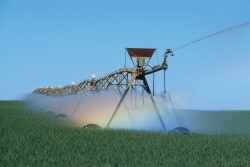 Centre Pivot Irrigation System |
Another big plus has been the ability to sow grazing wheat to provide feed for the ewes and lambs over winter, autumn and early spring. When it was flood irrigated, this option wasn’t practical, especially during the dry years. The Bourkes say the centre pivot has led to an increase in the productivity of the 40 hectares which was previously just used as a grazing paddock. While not able to quote exact figures, they firmly believe it has improved the tonnage per hectare produced from that area.
They also highlight that watering is a lot easier now, with more time available to do other things.
“Because it is an automated system, there’s no need to be up at night chasing water. It definitely saves time.” |
The only negative from the Bourkes’ perspective was the fact they had to pay the full cost of upgrading the power-supply transformer for the pump. However, in saying this, they did note the assistance they received from Powercor during this time was much appreciated, as they made the process easier by keeping the Bourkes informed and up-to-date during the upgrade.
Was the investment worthwhile?
The Bourkes commented they didn’t realise how much water they would save before they began irrigating with the centre pivot. They knew there would be water savings, but hadn’t really crunched the numbers.
Although not able to access any funding assistance to install the centre pivot, the family believes it is the best thing they have done to improve their farm. Having the ability to produce autumn and spring feed for their ewes and lambs is a huge benefit to their farming operations.
Given they were previously pumping water onto the property, the higher pumping costs for the centre pivot wasn’t much of an issue for them. The Bourkes are aware it only takes 36 hours to do a full cycle of watering, and this can be done on the weekend when they can use off-peak electricity. The usage of off-peak electricity along with shorter pumping times has greatly reduced the amount of electricity used, and so reduced the operating cost.
It might have been a different story if their previous irrigation system had been gravity fed, but their soil types, location on the farm, existing layout on the 40 hectares and their need for better water usage, meant the centre pivot would probably still have been their preferred option.
Would other farmers be interested in the change?
The Bourkes commented that other farmers in the area have already visited their property to look at the set up and discuss the difference it has made to the Bourkes’ productivity and farming operation. While some of these visits are purely out of curiosity about the new technology, they say a number of visitors are people genuinely interested in the potential of a centre pivot for their own properties.
Are pivots for everybody?
The Bourkes note that every situation is different and a centre pivot might not be the answer for all properties. They believe their Whole Farm Plan was useful in identifying the potential for a centre pivot on that particular part of their property. If the soil types had been heavier, the gravity flood infrastructure been modernised or native vegetation prevalent, a centre pivot would not have been the most appropriate technology to install. Individuals should take into account their own circumstances before making such a decision. A potential user needs to understand what they want to achieve and what the cost is going to be. For the Bourkes, the future benefits of the centre pivot far outweighed the initial cost of installation.
Research
Was the investment worthwhile?
The Bourkes commented they didn’t realise how much water they would save before they began irrigating with the centre pivot. They knew there would be water savings, but hadn’t really crunched the numbers.
Although not able to access any funding assistance to install the centre pivot, the family believes it is the best thing they have done to improve their farm. Having the ability to produce autumn and spring feed for their ewes and lambs is a huge benefit to their farming operations.
Given they were previously pumping water onto the property, the higher pumping costs for the centre pivot wasn’t much of an issue for them. The Bourkes are aware it only takes 36 hours to do a full cycle of watering, and this can be done on the weekend when they can use off-peak electricity. The usage of off-peak electricity along with shorter pumping times has greatly reduced the amount of electricity used, and so reduced the operating cost.
It might have been a different story if their previous irrigation system had been gravity fed, but their soil types, location on the farm, existing layout on the 40 hectares and their need for better water usage, meant the centre pivot would probably still have been their preferred option.
Would other farmers be interested in the change?The Bourkes commented that other farmers in the area have already visited their property to look at the set up and discuss the difference it has made to the Bourkes’ productivity and farming operation. While some of these visits are purely out of curiosity about the new technology, they say a number of visitors are people genuinely interested in the potential of a centre pivot for their own properties.
Are pivots for everybody?
The Bourkes note that every situation is different and a centre pivot might not be the answer for all properties. They believe their Whole Farm Plan was useful in identifying the potential for a centre pivot on that particular part of their property. If the soil types had been heavier, the gravity flood infrastructure been modernised or native vegetation prevalent, a centre pivot would not have been the most appropriate technology to install. Individuals should take into account their own circumstances before making such a decision. A potential user needs to understand what they want to achieve and what the cost is going to be. For the Bourkes, the future benefits of the centre pivot far outweighed the initial cost of installation.
Based upon the historical climate data for Tatura, the minimum recommended system capacity is 12 mm/day. To achieve an irrigation of 20 to 25 mm, a full circle would need to be set to occur over two days. Stage of crop growth, time of year and rainfall also need to be taken into consideration when deciding when to schedule irrigations, but can usually be easily programmed and handled by modern centre pivot control systems.
The major running costs of pressurised irrigation systems are directly related to pumping. Typical energy requirements are 130kWh/ML pumped, so at a peak electricity charge of 28c/kWh, the cost is
$36/ML. If off-peak power can be used, the cost will be about half. Diesel operated pumping will typically require 39 litres of diesel per ML applied. Therefore in the Bourkes’ system, each irrigation will use nearly 1,000 kWh of electricity, and cost approximately $120 to $270, depending upon the electricity price tariff and supply charge.
Further information
For more information about irrigation technologies, go to:
- www.dpi.vic.gov.au/dpi/vro/vrosite.nsf/pages/lwm_farmwater_efficient_irrigation_design_4.2
- DPI Ag Note# AG1280. Centre Pivot System Capacity. Published: June 2007
- DPI Ag Note# AG1281 Centre Pivots – Capital and Operating Cost Trade-off. Published: June 2007
- Talk to an irrigation surveyor and designer or a company that supplies and installs travelling irrigation systems.
- Call DPI at Echuca (03 5482 1922) or Tatura (03 5833 5700) and ask to speak to an Irrigation Modernisation Officer.
- Talk to other farmers who have installed centre pivot or lateral move irrigators.
..................................................................................... |
A Gradual Transition to Dryland
Who: Barry and Donna Smith
Where: Loddon Valley irrigation area
Enterprise: Cropping and grazing
What: Irrigation properties purchased and converted to one mixed dryland farm
On the farm
Background
Barry and Donna started out farming as irrigators. In the early 1990s the cost of water was reaching a point where they felt it was becoming unviable to keep irrigating, so they began a process of transitioning into dryland agriculture. The decision to expand into dryland agriculture was reinforced by the drought conditions in recent years.
Because of the dry conditions, the last irrigation occurred 4 years ago. Although water became available again in 2010, it was carried over to this year. It will be used to irrigate lucerne to finish the prime lambs, which was the primary use of irrigation before the drought.
Their property is now 1,740 ha in area; of which 32 ha is still able to be irrigated with the 40 ML water right still remaining.
What have you changed?
Purchasing irrigation properties and using them for dryland agriculture has required Donna and Barry to make a number of changes to the farms. This has included earthworks and fencing, filling-in the irrigation channels and pulling out the channel stops, as well as ensuring infrastructure is available for the stock and domestic water supply – which involved installing pipes and troughs, and in one case connecting to the irrigation backbone.
These changes can be costly. As an example, one 324 hectare dairy property purchased by the couple required $45,000 worth of contractor work for earthworks. Barry worked for 2 months solid preparing the area for dryland cropping, including pulling out channel stops and removing 12 km of fencing. Other properties they have purchased have required about a month of Barry’s labour.
These changes maximise the efficiency of future cropping practices by expanding the area of each paddock to a size that is optimum for cropping machinery.
Ongoing costs are also associated with transitioning irrigation paddocks into dryland paddocks. Soils in areas where channels have been removed have a tendency to slump over time. These require topping up 2 years after the initial work is done and then again 3-4 years later. In the past, this has required about 2 weeks of Barry’s labour.
Preparing irrigation land for dryland agriculture is generally a smooth process that takes about 6 months. However, discussions with the relevant organisations to disconnect properties from the system can be lengthy.
What made you decide to expand into dryland farming?
The decision to expand the area of dryland agriculture and reduce irrigation has been the result of low water availability and high water prices making dryland farming more viable than irrigation.
The decision to increase their area of dryland farm has been relatively easy for Barry and Donna, as it has happened gradually over many years. They believe it is important to be continually adapting to changing conditions.
“Drought taught us how to farm without water. So now we are farming more Mallee style. These changes can be hard for the older generation.” |
What made you decide to expand into dryland farming?
The channel supplying the remaining irrigation on the property is currently open and discussions to decommission this channel as part of the Northern Victoria Irrigation Renewal Project (NVIRP) will occur in the future. Decommissioning the channel will provide both challenges and opportunities.
For example, the channel water is used for stock and domestic supply and provides a barrier for sheep in some paddocks. Therefore, infrastructure to continue the supply of stock and domestic water will be needed and additional fencing may be required in some paddocks where channels are removed. Compensation will be needed for the associated costs.
“It’s important to remember filling-in channels also results in filling-in of drainage systems that are important when salinity is present.” |
On the positive side, decommissioning the irrigation channel could provide an opportunity to change the layout of the land to maximise efficiency, for example, establishing larger paddocks for cropping and adding potential vegetation buffer strips.
If the channel is decommissioned, Barry and Donna will expand their current dryland cropping into the remaining irrigation paddocks. This will be a relatively easy transition.
Have you been able to find good information?
Donna and Barry are predominantly dryland farmers and will only require limited new information to further expand their operation. However, they recognise gaining knowledge is an important first step for those who haven’t been involved in dryland farming before.
Understanding the soil capability of a farm and the expected returns from district averages is important, especially as returns can vary greatly from district to district. Donna and Barry also believe it’s important to use local farm networks to access local knowledge.
Modern tractors and headers generally have a lot of technology associated with them, so undertaking training sessions on this equipment, as Barry has done, can be very useful.
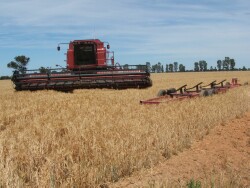 A wheat crop ready to be harvested | 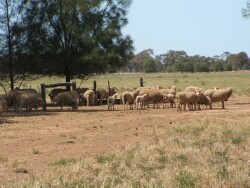 Sheep graze in a lucerne paddock |
|
|
Research
The impact of the drought, water trade, unbundling water from land and channel rationalisation on irrigation farming in the Goulburn, Murray and Loddon irrigation districts over the past 10 years has been enormous. Mapping of irrigated land-use change across the region from 2003 to 2008 has recorded a drop in perennial pasture from 141,000 ha to 35,000 ha. Autumn pasture/crop has dropped from 73,000 ha to 32,000 ha (DPI 2010). Overall irrigation activity reduced 40% and perennial pasture reduced 75%. This follows on top of changes mapped between 1996 and 2003, when the area of perennial pasture fell from 203,000 to 141,000 ha. (Morse-McNabb et al 2008.)
For landholders like the Smiths who wished to remain farming whilst adapting to the changes going on in the region, their decision to trade water for land area is a reflection of the regional figures. Barry and Donna clearly recognise the profitability of dryland farming is substantially lower than irrigation farming. Australian Bureau of Statistics figures (ABS 2006) found farms that irrigated, generated on average 55% more output per farm in 2003–04 than farms which did not irrigate, hence the need to increase farm area to maintain enterprise scale and profitability.
While the Smiths may yet end up having their last remaining irrigation supply decommissioned, for any farm enterprise, keeping it open as an option provides additional security and resilience to the enterprise. Particularly given the uncertainty of drought and the failure of timely rains in some years, the ability to maintain lucerne production during a dry phase, or to be able to finish off a spring crop if the rains fail, is potentially beneficial. Especially in seasons with high water availability, temporary trade of water will be cheap, so retaining the ability to capitalise on such opportunities may be valuable for many farm enterprises, as well as for the regional community and economy.
Reference
McAllister A, 2010. Understanding Landholders: Changing Land use in the GMID. Milestone Report, DPI.
Morse-McNabb L, McAllister A, Kaine G, Rowbottom B and Linehan C. 2008. Spatial market segmentation and Health productive landscape framework. DPI report. ISBN 978-1-74199-971-6
ABS, 2006. Characteristics of Australia’s Irrigated Farms 2000-01 to 2003-04, #4623.0, ISSN 0 642 48224 1
Further information
For more information about post irrigation options:
- Call DPI at Echuca (03 5482 1922) or Tatura (03 5833 5700) and ask to speak to an Irrigation Modernisation Officer.
- Talk to other farmers in your district who have made transitions away from irrigation.

